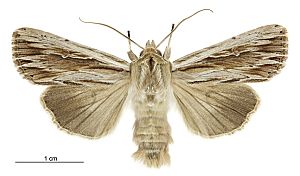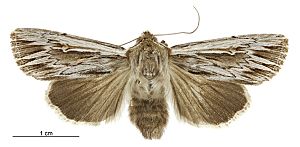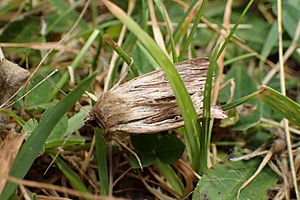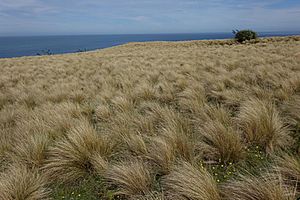Persectania aversa facts for kids
Quick facts for kids Persectania aversa |
|
|---|---|
 |
|
| Male | |
 |
|
| Female | |
| Scientific classification | |
| Synonyms | |
|
The Persectania aversa, also known as the southern armyworm, is a type of moth. It belongs to the Noctuidae family. This moth was first described in 1856 by Francis Walker. It is found only in New Zealand. You can find it throughout the country. This includes the North, South, Stewart and Chatham Islands.
This species lives in open grasslands. The young moths, called larvae, eat different types of grass. They also eat important farm crops like oats and barley. Because of this, the southern armyworm is sometimes seen as a problem for farmers. Adult moths are active at night. They are often attracted to lights. You can see them flying throughout the whole year.
Contents
About the Southern Armyworm's Name
This moth was first described by Francis Walker. He named it Leucania aversa. For a while, there was some confusion about its name. People sometimes mixed it up with a similar moth from Australia.
In 1954, a scientist named I. F. B. Common studied the moth closely. He looked at its body parts. He confirmed that P. aversa was a unique species. He also confirmed it lives only in New Zealand. Later, in 1988, J. S. Dugdale agreed with Common's findings. This means P. aversa is the only species of its kind that lives only in New Zealand. The first female moth specimen used for its description is kept at the Natural History Museum, London.
What the Southern Armyworm Looks Like
Francis Walker described this moth as being "pale fawn-colour." This means it's a light yellowish-brown color. Its chest area has brown bands. The front wings have a white line with brown edges. They also have brown streaks with white edges. The back wings are pale. They have wide brownish borders.
Adult moths have a wingspan of about 1.5 inches (about 3.8 cm).
Where the Southern Armyworm Lives
The southern armyworm lives only in New Zealand. You can find it all over the country. This includes Stewart Island and the Chatham Islands. It is thought to be common. However, it is less common in the northern part of the North Island.
Where It Lives and What It Eats
This moth lives in open grassy areas. This includes pastures where animals graze. The young moths, called larvae, eat many different types of grass. Some of the plants they eat include Ammophila arenaria, Avena sativa (oats), Festuca novae-zelandiae, Hordeum vulgare (barley), Nassella trichotoma, Phleum pratense, Poa annua, Poa cita, Poa colensoi, and Triticum aestivum (wheat).
Southern Armyworm Life Cycle
The southern armyworm lays white or light brownish-yellow eggs. These eggs are laid on the plants the larvae will eat. The eggs hatch after about seventeen days.
The larva, or caterpillar, has a green underside. Its body is brown with a reddish or pinkish tint. It also has black, red, and white lines along its back and sides. The larva then turns into a pupa. This happens on or just under the soil surface. This species usually spends the winter as a pupa. Sometimes, it can also spend the winter as an adult moth.
Southern Armyworm Behavior
Adult southern armyworm moths are active at night. They are often drawn to lights. You can see these adult moths flying throughout the entire year.
Diseases Affecting the Moth
The southern armyworm can get sick from certain diseases. It is known to be affected by a fungal disease. There is also a virus that can cause many larvae to die.
How It Affects Humans
The southern armyworm is sometimes considered an agricultural pest. This means it can cause problems for farmers. It is known for damaging grass-like crops. However, a special type of parasitic wasp has been introduced. This wasp helps to control the number of southern armyworms. This has greatly reduced the problems they cause.



